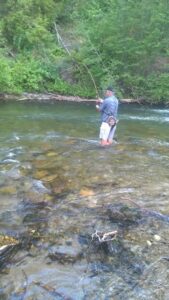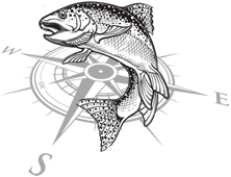Freestone River Approach

We as fly anglers usually are fly fishing one of the following: tailwater rivers, freestone rivers and lakes. How we fly fish these waters are different from one to the other. Tailwaters are rivers born from the bottom of a reservoir while freestone rivers are unencumbered by man or no dams. A more idealistic view to the two would be tailwater rivers are in the valleys and freestone rivers are in the mountains. Now of course this is a general view and there are many exceptions to this rule but it’s an easy way to look at it. If you know what kind of river you will be fly fishing then the type of river you choose to fly fish will dictate how you fly fish it.
The simple and scientific difference between the two rivers is the trout themselves. Freestone river trout have a large search or prey image and the tailwater river trout have a very narrow search or prey image. Without getting all science on you and turning Freestone River Approach into a paper of the differences between trout rivers let me make this a little simpler for you to grip. Tailwater trout are very picky during a hatch while freestone river trout aren’t picky at all and will at times pretty much eat any dry fly assuming it’s the right size and floating on the surface. Or another way to look at it is on the tailwater river you better have the right fly or you are going to have a long day. However, on a freestone river you better make the fly you choose float at all times on the surface or you will have a long day.
On many freestone rivers the rivers themselves can be very infertile or even sterile of aquatic insects. Unlike a tailwater river where the rivers bio mas and aquatic insect population are huge the freestone river lacks all those qualities. In many freestone rivers the are so few hatches that the trout that live in them are near starvation at all time. Hence the large search or prey image. It’s pretty clear to us on a tailwater river when we see at hatch in progress and trout feeding on these bugs, where the trout are and what they may be eating. It’s a no brainer from there. However, on a freestone river we may not see a hatch at all but we can easily catch trout on a dry fly because these trout are actively searching the surface for anything that may resemble food. Fly selection is not crucial but drifting your fly naturally high and dry is.
When we talk about approach we talk about how you put yourself on the river to begin casting. If all I need to begin dry fly fishing a freestone river is a dry fly then where do I cast my dry fly? If you were talking about a tailwater river then the answer is at a rising trout. In a freestone it common to approach a freestone and not see any fish feeding or rising. If that’s the case the question of where becomes pretty important. To begin to answer the above question we first have to understand that trout are capable of doing only 4 things: feeding, resting, safety and spawning. To take that a little further, they can only do one of those four things at a time. A trout can’t rest and feed or spawn and rest at the same time and so on. What we know is if we see trout feeding in a tailwater river then they aren’t capable of performing the other four things at that time. For example, a feeding trout is hard to scare. If you do go Boo to the feeding trout it will scatter for a few minutes and then resume feeding.
On a freestone river, because of the trout’s large search image, we know we can use a dry fly even though we see no trout rising or feeding. Remember freestone river trout spend a lot of time looking up. Basically on a freestone river when we approach the river we may not see any trout feeding. So let’s bring up the question of where to cast the dry fly again. The simple answer is we are going to cast are dry fly where we think there are trout. Usually, if not always, you will cast your fly to a seam. A seem is where fast water and slow water meet. That’s where all trout live, no matter if it’s a tailwater river or a freestone river. We may not see any trout feeding or rising but if there are trout in the river a seam is where they are going to be. Now this is where approach becomes one of the most important part of your fly fishing strategy.
Your approach to the river, whenever possible, should always be downstream or behind where you believe trout to be. At this point I assume you have a good reason to be where you are and have an idea of where there may be some trout to cast to. So we agree there may be trout right where the seam is. If are assumption is correct then we have a good chance in ripping a lip or two. What do we know about those freestone river trout that we hope might be lying on that seam? Well we don know anything about those trout. But what we know is they must be doing one of four things: feeding, resting, spawning or safety. Experience has shown me that those freestone river trout are real concerned at most times for their health, they are pretty spooky. Unlike a tailwater feeding trout that is hard to scare, not so for a freestone river trout, they are extremely frightened for their safety.
On that freestone river where you are making your approach there maybe 10 or 15 trout living along that seam behind a boulder that you are eying on casting a dry fly too. I can tell you that everyone of those trout are spooky and concerned for their health. That means if you scare one you will likely scare all of them permanently, you might as well move to another spot because those slime rockets are now hiding in panic. There is nothing on earth scarier than a trout.
Your approach on freestone rivers is always downstream behind where you believe trout to be whenever possible. By taking this approach you will be casting you fly from the bottom of a run or seam to the top. While doing that if you do catch a trout it won’t scare all the trout in from of him leaving you more trout to cast too. By being behind the trout this allows you to keep you cast short and accurate. When you have worked or exhausted the lower section of the run or seam instead of making a longer

